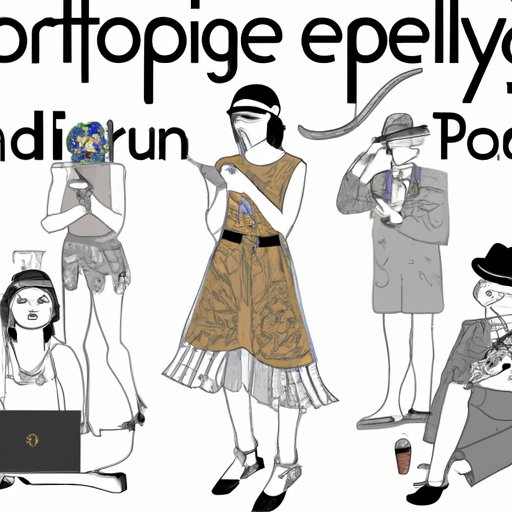Introduction
The 1920s were a decade of great change and transformation in many aspects of society, including youth culture. This period, often referred to as the “Roaring Twenties” or the “Jazz Age,” was marked by new music, dance styles, fashion trends, and social norms. During this time, young people began to embrace more modern values and behaviors, which had a lasting impact on future generations. This article explores how youth culture changed during the 1920s and the various factors that contributed to these changes.
Impact of the Jazz Age on Youth Culture
The Jazz Age had a profound effect on youth culture in the 1920s. According to historian Thomas Doherty, “youth culture had been around for decades, but it was the 1920s that gave it a voice, a look, and an attitude.” During this period, jazz music and dance styles became increasingly popular among young people, sparking a revolution in terms of style and expression. As jazz spread, so did the idea of nightlife and nightclubs, which became popular venues for young people to socialize and express themselves.
This newfound sense of freedom and expression also led to an expansion of social interaction among young people. Increasingly, they began to gather in public spaces such as parks and movie theaters, giving them more opportunities to interact with one another and develop relationships. This shift in behavior had a significant impact on youth culture, as it allowed young people to express themselves in ways that were not previously possible.

Increasing Popularity of Flappers and Their Influence on Youth Culture
During the 1920s, the flapper emerged as a distinct figure in youth culture. Flappers were young women who embraced a more modern lifestyle and rejected traditional gender roles. They wore short skirts and dresses, smoked cigarettes, and attended parties and nightclubs. Their rebellious nature and free-spirited attitude quickly made them icons of the Jazz Age.
Flapper fashion and behaviors gained increasing acceptance among young people during the 1920s. This trend was reflected in the media, which began to portray flappers in a positive light. The popularity of flappers also had an impact on gender roles, as their rejection of traditional expectations challenged societal norms and paved the way for greater gender equality.
Rise of Consumerism in Youth Culture
In the 1920s, consumerism began to play an important role in youth culture. For the first time, young people had access to credit cards, enabling them to purchase goods without having to pay upfront. Advertising also grew in prominence, as companies sought to target young consumers with their products. This shift in attitudes toward money and spending habits had a significant impact on youth culture, as material goods began to take precedence over other forms of expression.
The rise of consumerism also led to the development of brand loyalty and trends. Young people began to follow particular brands and styles, creating a sense of unity and identity among those who shared similar tastes. This phenomenon had a major influence on youth culture, as it created a culture of conformity and competition in terms of material possessions.
Role of Media in Shaping Youth Culture
The media played an important role in shaping youth culture in the 1920s. Radio and movies provided a source of entertainment and escapism, while magazines and newspapers served as sources of information and advice. Celebrities and role models emerged during this period, giving young people something to aspire to and providing them with inspiration.
The media also had a powerful influence in terms of values and beliefs. Through radio, movies, and print media, cultural values and ideas were spread to a wide audience. These messages had a profound effect on youth culture, as young people began to embrace more modern values and reject traditional ones.

Evolution of Social Mores and Values in Relation to Youth Culture
The 1920s saw a dramatic shift in social mores and values in relation to youth culture. Traditional views on sexuality and relationships began to give way to more modern ideas, as young people embraced a less restrictive approach to sexual expression. Similarly, there was a move away from traditional values towards more progressive ones, such as the importance of individual freedom and self-expression.
The influence of religion also declined during this period, as young people began to reject the strict moral codes of their parents’ generation. This shift in values had a significant impact on youth culture, as it allowed young people to express themselves in ways that were previously impossible.

Expansion of Educational Opportunities for Young People
The 1920s saw a significant expansion of educational opportunities for young people. Access to higher education increased, with more students attending college than ever before. Vocational programs and technical schools also developed during this period, allowing young people to gain new skills and knowledge. Additionally, student activism and political involvement grew in prominence, as young people began to take an active role in shaping their own futures.
Conclusion
The 1920s were a period of great transformation in terms of youth culture. The Jazz Age sparked a revolution in terms of music, dance styles, and fashion, while flappers challenged traditional gender roles and ushered in a more modern era. Consumerism and the media also had a major influence on youth culture, as they spread cultural values and beliefs and shaped young people’s spending habits. Finally, the expansion of educational opportunities enabled young people to become more politically engaged and socially aware. The changes that took place in the 1920s had a lasting impact on modern youth culture, and their legacy can still be seen today.
(Note: Is this article not meeting your expectations? Do you have knowledge or insights to share? Unlock new opportunities and expand your reach by joining our authors team. Click Registration to join us and share your expertise with our readers.)
